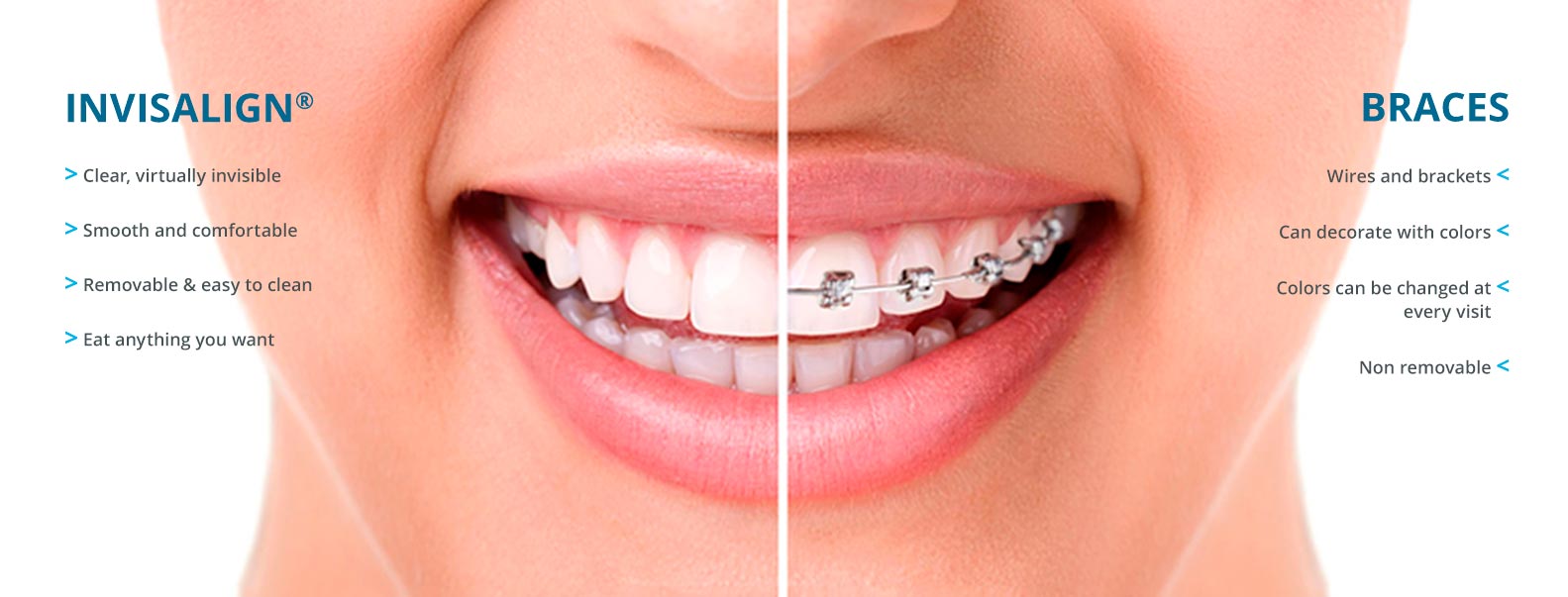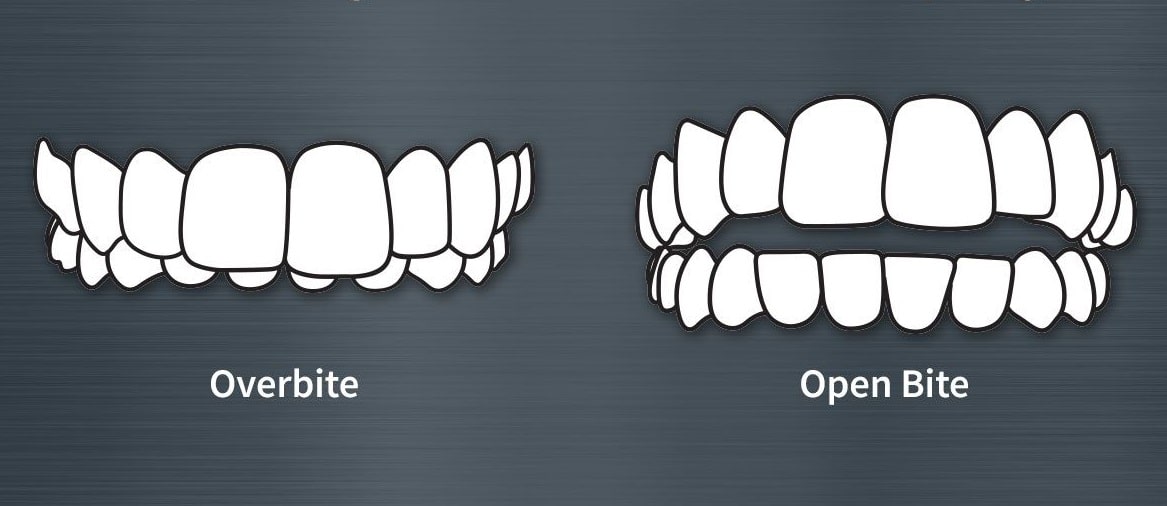The term overbite is one of those terms that creates visuals in many people’s minds. It spurs people to think of contraptions strapped to the head, years of braces, and cartoon characters. But the reality is…that’s not really what it is. In fact, having an overbite is something everyone has.
In this article, I’ll explain what an overbite is, why having an overbite can be normal, and why correcting an overbite is important when there are problems with it.
What Is An Overbite?
It’s a common misconception to think that having an overbite indicates a problem. However, its merely a measurement. An overbite is measurement of how much the top front teeth and the bottom front teeth overlap when a person bites.
Think of an overbite like the fable Goldilocks and the Three Bears. When you consider a spectrum of options between two extremes its best to be right in the middle—not too much and not too little.
Consider an overbite in the context of eating pizza. If the top and bottom front teeth have space between them when fully closing the jaw, it would be difficult to bite off a piece of pizza. The pizza would just slide out without taking a bite.
And if the front teeth and bottom teeth have overlap excessive, you would bite though the pizza much deeper than needed which is inefficient. That’s the concept of how an overbite functions.
Okay, so what is a normal overbite?
2-3mm overbite is ideal. That means the top front teeth overlap the lower front teeth by about 2-3mm.
When an overbite measures too far out of the normal average, we call that an malocclusion. That’s when its best to consider improving it.
What causes a bad overbite?
An excessive overbite is a type of malocclusion. And if you have an excessive overbite and are stressing out, please know that you’re not alone. Studies show that a significant portion of the population have bad overbites if they have not had the opportunity to have orthodontics yet.
So what causes an overebite? Well it’s a combination of factors.
The overbite is may be related to genetics and development such as if your parents had issues with an overbite, then it increases the likelihood of developing issues.
It can also be molded by behavior such as if a child sucked their thumb or had excessive pacifier use. If you’re an adult, you’re not off the hook. There are things that contribute to changes in overbite in adulthood as well. Some examples of habits that contribute are nibbling fingernails and teeth grinding.
Various movements that our mouths are exposed to, overtime, begin to adapt the shape. These adaptions can change the overbite, for better or for worse.
How to Treat an Overbite

If you’re wondering how an overbite is treated, it’s best to consider it from the concept of whether it’s the treatment of a child or an adult. An overbite is caused by a combination—it’s both skeletal (such as the shape of the jaw) and dental (such as the position of the teeth).
For children, the name of the game is prevention. Because a child is still growing, the skeletal causes of an overbite and the teeth causes can both be addressed. Therefore, in children treatment has to do with guiding the growth to improve it.
When it comes to adults, the skeletal structure is fixed. Therefore, treatment cannot leverage the power of growth. In adults, an overbite is improved by adjusting the alignment of the teeth.
So what needs to be done to correct an overbite?
Well, let’s keep it simple. Since the overbite is simply the measurement of how much the teeth front teeth overlap, treating it is simply increasing or decreasing the overlap. Here’s some techniques that your dentist or orthodontist may suggest:
Treatment in Children and Teens
- Removal of baby teeth to make space to improve the position in the adult teeth
- Growth modification device such as headgear or a palate expander—these devices help guide the bones of the jaw to grow in a more ideal proportion
- Braces apply gentle pressure to the teeth which improve the position of the teeth and jaw
- Retainers act as a way of holding a position so that the overbite does not change during growth or from other behavioral factors
Treatment in Adults
- Braces and Invisalign – move the teeth into a more favorable position
- Teeth removal – teeth removal is not the first choice, but occasionally if the teeth are excessively crowded a tooth needs to be removed to create space for the rest of the mouth.
- Surgery – when the overbite is so excessively malpositioned, sometimes surgery is recommended to improve the bite position. Surgery is typically rare and is needed in less than 1% of cases.
Why Is Correcting An Overbite Important?
There’s a common drive for people to want to fix an overbite for cosmetic reasons. And there’s nothing wrong with that, but it’s so much more. When someone has a poor overbite it can cause a world of functional problems.
As a TMJ specialist, the big issue with a poor overbite is that it can create functional issues. These issues can range from mild tenderness when chewing, to drastic headaches, to even ear pain.
The reason the overbite causes TMJ issues is simple. The front teeth of the mouth act as a fence. Think about it. The top teeth are fixed—only the lower jaw moves. So as the lower jaw moves, it must fit within the overlap of the top front teeth. If the overlap of the teeth is off, wouldn’t you think that would cause problems?
It turns out it does.
The overbite is like fitting a puzzle piece together—it fits best one way. So what happens when the overbite is off, the jaw begins to try to accommodate it. The jaw is repetitively forced into a sub ideal position with each bite, and over time that creates problems.
Some TMJ problems common to having an overbite that is poor are:
- Fatigue when chewing
- Headaches
- Ear pain
- Tinnitus
- Jaw soreness
- Clicking and popping of the TMJ
- Trismus or lockjaw
So as you can see, my biggest concern with a poor overbite is the functional concerns. The cosmetic improvements are a bonus.
In addition to TMJ disorder, some other issues that happen with a bad overbite are:
Gum damage—the lower front teeth can overlap so far that they contact the gum line on the back of the upper front teeth.
Difficulty speaking—the front teeth have a large factor in forming various words particularly the “f” and “s” sounds. When someone has a drastic overbites it sometimes can affect speech pronunciation.
Tooth wear and tooth chipping—when the teeth are overlapping excessively there is unnecessary contact along the length of the teeth which can lead to additional wear or chipping of the teeth.
Sleep apnea—the condition of sleep apnea involves obstruction of air while sleeping. A factor in the obstruction of air has to do with the lower jaw position. Studies show that if overbite is preventing the jaw from entering into a relaxed forward position when sleeping, it contributes to sleep apnea.
The Bottom Line
An overbite is the measurement of overlap between the top and bottom front teeth. There is a normal healthy range which is about 2-3mm of overlap in the average person. When overbite is excessive or insufficient, it can put people at risk for a number of cosmetic and functional issues.
The best place to start is to discuss with your dentist. They may have suggestions for you or they may refer you to an orthodontist. When it comes to children, the best technique is prevention. It’s easier to prevent an overbite from forming during growth than it is to reverse it.


